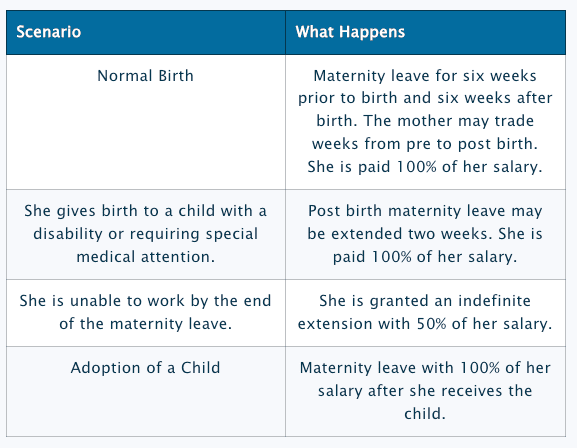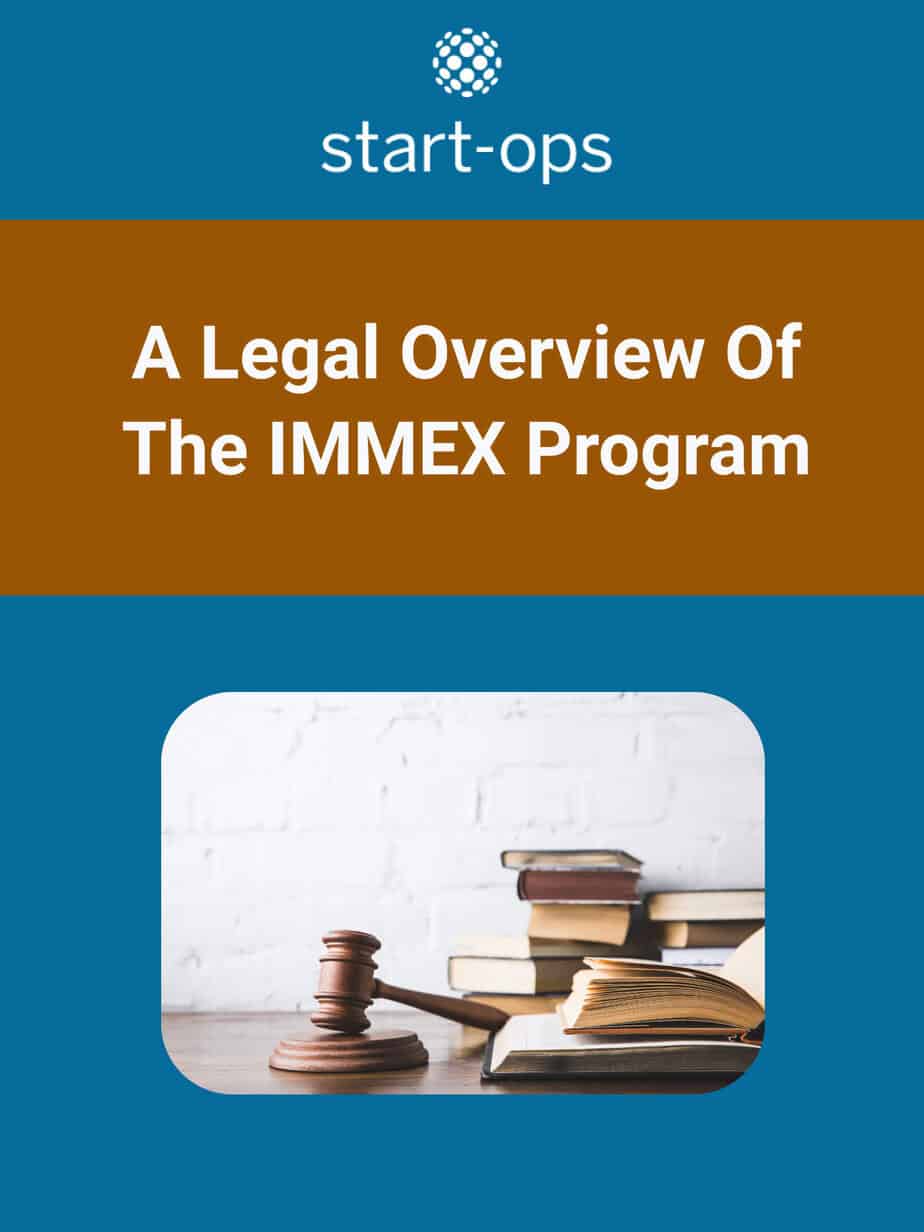Last updated on May 13th, 2024 at 04:53 pm
Maternity leave is a mandatory employee benefit in Mexico. It allows mothers to give birth to their children and nourish them in the first weeks of their lives without worrying about work. Foreigners starting a business in Mexico must be aware of these nuances. Otherwise, the labor authorities will penalize your company.
Women’s rights are a key component of Mexican labor laws. The fifth title of the Mexican Federal Labor Law regulates everything related to women’s work, including maternity leave. Mexican legislation sees men and women as equal, as stated in Article 2 of the Labor law.
Although maternity leave in Mexico is a component of Mexican payroll taxes and Mexican Social Security Calculation, there are some nuances that foreigners who own a Mexican company must know. This article aims to explain everything about maternity leave in Mexico in 2024. We will also explain the process employees must undergo to obtain the subsidy.
Let us get to it.
Legal Overview Of Maternity Leave In Mexico
Mexican Political Constitution does not directly reflect maternity leave. However, there are laws stemming from it to fill out any legal gaps. After all, it is really hard to regulate an entire country in one little book.
Therefore, to fully understand this, we have to refer to Article 170 of the Labor Law, which discusses the rights of working mothers. This article is very important since many obligations for Mexican companies stem from it.
Working Mothers’ Rights
General Rights
During pregnancy, working mothers should not perform any work that demands considerable effort, like lifting, pulling, or pushing heavy objects or anything that may put them or the child in danger. That makes sense if you think about it. They should not perform heavy duties that require too much strain on their body.
As a side note, working mothers are not legally obligated to inform their employer if they are pregnant. This is one of those legal things that does not make sense. However, in practice, the employees usually do it since it works for their benefit. You should also create a company culture where employees are incentivized to tell.
Coming back to the dangerous and unhealthy work, in case anyone questions what it is, Article 167 of the Labor law explains it.
LFT Article 167 – For the purposes of this title, dangerous or unhealthy work is that which, by the nature of the work, by the physical, chemical and biological conditions of the environment in which it is performed, or by the composition of the raw material used, is capable of affecting the life and physical and mental health of the pregnant woman or the product.
There is no need to linger too much on this. If you think hard enough, you can guess what work pregnant women cannot do. So, if one of your employees is pregnant, do not ask her to do it.
Companies’ policies concerning pregnancy and Maternity leave in Mexico must be clearly stated in their Internal Work Regulations. This document states all rules and policies inside a company. It can be thought of as the laws inside a company, which must be aligned with Mexican Law.
Also, working mothers have the right to get their maternity leave period computed in their antiquity. Antiquity is an important concept for workers because they accrue benefits during their time working for a company,
Returning to Work
Working mothers also have the right to return to work after having their baby, although this is conditioned on being absent less than a year after giving birth. Although there may be some weird cases where a working mother needs that much time, this is usually enough. Also, as we will see, maternity leave in Mexico is not subsidized that long.
Paid Maternity Leave In Mexico
Let us see exactly what the law states regarding maternity leave in Mexico. Here are the related fractions of Article 170 of the Labor Law word-for-word.
Art. 170 – Fraction II. They shall enjoy a rest of six weeks before and six weeks after childbirth.
At the express request of the worker, with the prior written authorization of the doctor of the social security institution that corresponds to her or, as the case may be, of the health service provided by the employer, taking into account the opinion of the employer and the nature of the work she performs, up to four of the six weeks of rest prior to childbirth may be transferred to after childbirth.
In the event that the children were born with any type of disability or require hospital medical attention, the leave may be up to eight weeks after the birth, upon presentation of the corresponding medical certificate.
In the event that authorization from private physicians is presented, it must contain the name and professional license number of the issuer, the date and the medical condition of the worker.
This is the nitty-gritty of maternity leave in Mexico. To summarize, women have the right to 12 weeks (84 days) of paid leave when they give birth. They may interexchange these weeks from prenatal to postnatal if they wish.
In the event of having a child with a disability or a particular need that requires medical attention, they get two extra weeks in the postnatal leave period.
Art. 170 – Fraction III. The rest periods referred to in the preceding fraction shall be extended for the necessary time in the event that they are unable to work due to pregnancy or childbirth;
Fraction IV. During the rest periods referred to in Section II, they shall receive their full salary. In the cases of extension referred to in fraction III, they will be entitled to fifty percent of their salary for a period of no more than sixty days;
There are often serious complications at birth, some lasting more than eight weeks. Therefore, there is an indefinite extension if the mother cannot return to work. For up to 60 days (after the original eight-week period, during which she receives 100%), she will receive a subsidy of 50% of her salary. It is important to note that there must be causes directly related to pregnancy.
It is essential to know that the salary you can register at the IMSS is capped. According to Article 28 of the Social Security Law, the maximum wage you can register for social security purposes is the equivalent of 25 Mexican minimum wages. Therefore, this is the maximum subsidy for maternity leave.
Transfer of Weks and Extension
As stated before, mothers can choose how they use their 12 weeks of maternity leave in Mexico to their benefit. For example, if they still feel fit to work six weeks before birth, they may interexchange some weeks after the birth. Here is an overview of the different combinations.

How does this work?
If the mother wants to transfer weeks, she must consult her doctor. The doctor will then assess clinically to determine whether she can do so.
This process begins at week 35 of the pregnancy. If the doctor accepts the request, he/she will inform the mother of the date she should return for the next consultation.
Adoption Leave In Mexico
This is straightforward. If the mother adopts a child instead of having it, she is entitled to a paid maternity leave six weeks after receiving the child. It is essentially the same as having a baby without the prenatal period. Fathers get five paid days of leave.
Breastfeeding Period In Mexico
Working mothers are entitled to two half-hour extraordinary daily breaks to feed their kids while breastfeeding. This right lasts up to six months after the baby is born. Also, the company must provide a suitable and hygienic place designated by the company.
Another option is to reduce her working day by one hour. This means instead of getting two half-hour breaks, she works one hour less. This reduction may be at the beginning or end of her shift.
Penalties For Not Complying
Maternity leave in Mexico and women’s related rights are a very serious matter. Therefore, labor authorities make regular audits to ensure compliance.
The penalty for non-compliance is between 50 and up to 2,500 UMA. In 2024, this would look like this.
| Minimum Fine | Maximum Fine |
|---|---|
| MXN $5,429 | MXN $271,425 |
| US $323.50 | MXN $16,175 |
Summary of Maternity Leave in Mexico
Ok, so this is a lot of information. Let us summarize this in a table.

Who Pays For Maternity Leave In Mexico?
This is an important one. After all, we are talking about a 12-week salary. The Mexican Social Security Institute (IMSS) pays the salary as a subsidy but only grants it to mothers who meet certain requirements.
What happens if your employee does not meet the requirements?
Article 103 of the Social Security Law is clear: IMSS will not grant the subsidy. Therefore, the company must pay for it.
Let us take a look at those.
Employee’s Requirements for Maternity Leave In Mexico
According to Article 102 of the Social Security Law, the employee must comply with specific requirements to receive the Maternity leave subsidy.
- She must be registered at IMSS for at least 30 weeks before the leave.
- She must be certified as pregnant by the institute and given a probable birth date.
- She must not perform any paid work during the maternity leave period.
Also, the child must be born at least after the 23rd week of pregnancy. Otherwise, it is technically an abortion, and it is treated as a general disease.
Employee’s Process To Certify Maternity Leave in Mexico
Maternity leave in Mexico is certified by issuing a Maternity Leave Unique Certificate. It has this name because, before 2016, employees needed to get two different certificates. One for the pre-birth period and one for the post-birth period. Also, workers can decide whether to attend their pregnancy with an IMSS doctor or to go to their family or trusted doctor.
If the employee decides to go with an external doctor, the procedure for the issuance of the unique certificate is as follows:
- She must go to her doctor since the pregnancy begins for regular treatment.
- Any day after the 34th week of pregnancy, she must go to an IMSS family physician (only once). This IMSS physician will issue the unique certificate.
- The employee must bring the following documents to this appointment:
- An official document showing the social security number.
- Valid ID with a photograph, usually INE or passport.
- An ultrasound that is not older than five weeks.
If the employee decides to go to an IMSS doctor, the process is as follows:
- She must go to the IMSS doctor as soon as she suspects a possible pregnancy so that appropriate prenatal surveillance can begin.
- The IMSS doctor will indicate to her person the number of visits she should have to maintain adequate prenatal control and the date on which she should present herself to issue the unique maternity leave certificate.
As stated before, mothers can transfer weeks from prenatal to postnatal. To do this, they must fill out the Weeks Transfer Application and get an employer’s approval and the authorization of their doctor. Once they have gathered these documents, they must deliver them to their IMSS family medicine unit.
Child Care Service
A benefit related to maternity leave in Mexico is the IMSS child care service. Once the child is born, the Mexican Social Security Institute offers free child care. These facilities offer working mothers and fathers the opportunity to take care of their babies since they are 45 days until they reach the age of four years.
Conclusion
Maternity leave in Mexico is a mandatory benefit. Mexican companies must comply, or they will face hefty fines. The regular paid leave is six weeks for the prenatal period and six weeks for the postnatal period. The Social Security Institute subsidizes the paid leave, granted that the working mother meets certain requirements.
If you enjoyed this article, please share it with someone you believe would benefit. If you have any questions, please leave them in the comments.


